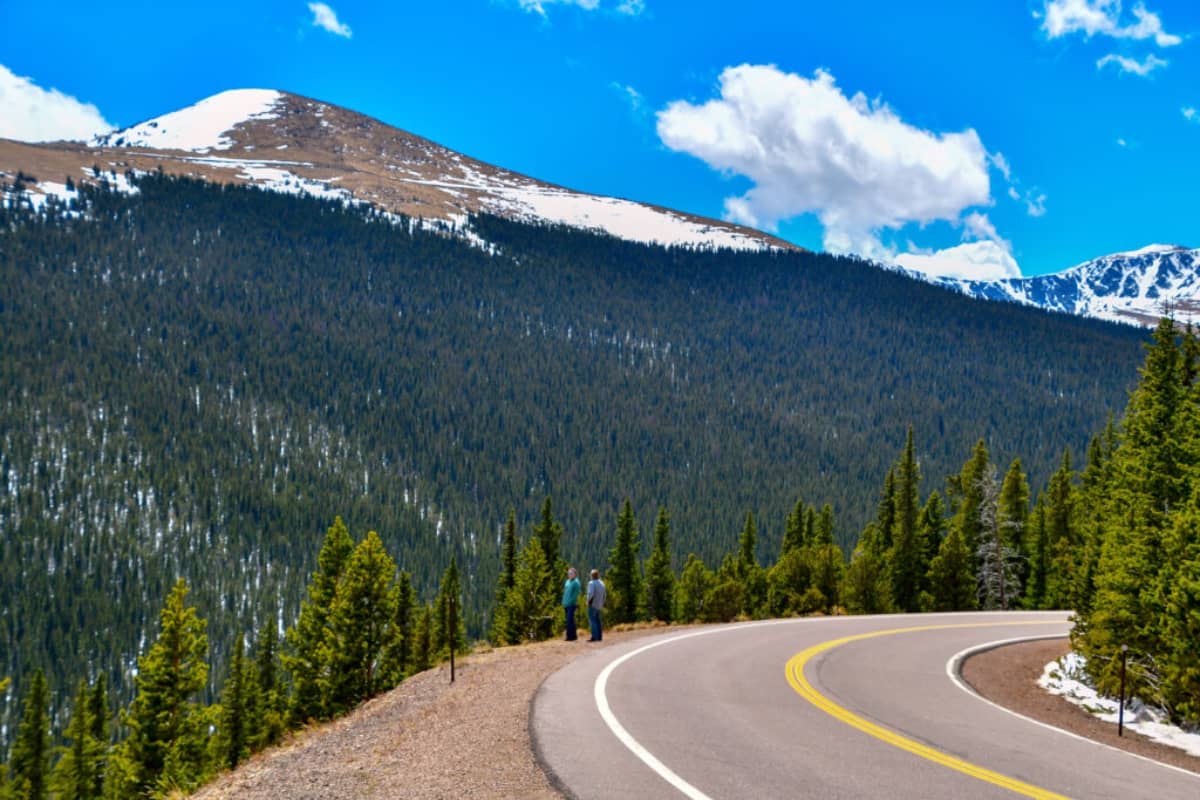The Mount Evans Scenic Byway, known for being the highest paved road in North America, offers an incredible driving experience that showcases Colorado’s alpine beauty. However, beneath its breathtaking vistas lie several hidden dangers that drivers and visitors should be aware of before embarking on this journey. Here’s an in-depth look at six hidden dangers at Mount Evans Scenic Byway, based on real experiences and recommendations from seasoned travelers.
1. Steep Drop-offs and Lack of Guardrails
Mount Evans Scenic Byway is a nerve-wracking drive for many due to the steep drop-offs along its narrow, winding roads. As you ascend the byway, you quickly leave the tree line behind and enter a tundra landscape where the road hugs the mountain tightly. This means there is little room for error—especially since most sections of the road lack guardrails. Drivers are often faced with sheer drop-offs on one side, and oncoming traffic on the other, making it essential to stay highly focused and cautious. It’s particularly dangerous during tight turns and switchbacks near the summit, where even a slight miscalculation could lead to a disastrous fall.
2. Altitude Sickness
One of the most significant hazards on the byway is the extreme altitude, which can trigger altitude sickness in those not acclimated to high elevations. Mount Evans rises to over 14,000 feet, and rapid elevation gain (especially if coming directly from lower altitudes like Denver) can cause symptoms such as dizziness, headaches, nausea, and shortness of breath. Travelers who live near sea level are especially prone to this, and it’s essential to allow time for acclimatization before reaching the summit. Even if you’ve never experienced altitude sickness before, the combination of physical exertion and the thin air at the summit can leave you feeling disoriented and unwell.
3. Unpredictable Weather
The weather on Mount Evans can change dramatically within a short time frame. At the base, you may experience pleasant temperatures, but as you approach the summit, it’s not unusual for the temperature to drop by 30 degrees or more. The wind can be strong and biting, even in the middle of summer. In July, visitors have reported temperatures around 45°F at the summit, with wind chill making it feel much colder. Sudden rainstorms or even snow can occur, catching drivers off guard and making the already challenging road conditions even more hazardous. It’s crucial to check the weather forecast before setting out and to bring layers of clothing to stay warm.
4. Wildlife Encounters
The scenic byway is home to a variety of wildlife, including mountain goats, bighorn sheep, and marmots, which are often seen grazing near the road. While spotting these animals adds to the allure of the drive, they can also pose a danger. Wildlife may unexpectedly wander onto the road, creating a hazard for drivers. Mountain goats, in particular, are known to stand their ground and can become assertive if they feel threatened. Visitors are advised to keep a respectful distance from wildlife and be vigilant to avoid accidents.
5. Rough Road Conditions
Despite being a paved road, parts of the Mount Evans Scenic Byway can be uneven and rough, particularly near Summit Lake. The road becomes bumpier as you ascend, and it can be especially challenging to navigate in poor weather conditions. Additionally, because of the high altitude, the road is often subject to harsh conditions like frost heaves and cracks, which can make driving more treacherous. Drivers should take their time and proceed with caution, especially in areas where the pavement is deteriorating.
6. Traffic Congestion and Limited Turnaround Options
Mount Evans Scenic Byway is a popular destination, and during peak times, traffic congestion can add to the stress of navigating the road. This is particularly concerning on the narrowest sections of the byway, where turning around is nearly impossible. If you encounter heavy traffic or find yourself behind a slow-moving vehicle, it may take longer than expected to reach the summit. Moreover, in certain areas, passing is difficult, and drivers must sometimes pull over to let oncoming vehicles pass. It’s recommended to visit early in the morning, not only to avoid traffic but also to enjoy the best light for photography.
Practical Tips for a Safe Drive on Mount Evans Scenic Byway
Given the hidden dangers, here are a few practical tips to ensure a safe and enjoyable experience:
- Plan for Acclimatization: Spend at least a day or two in Denver or a similar elevation to give your body time to adjust to the thinner air before attempting the drive to Mount Evans.
- Dress in Layers: Even on a warm day at the base, expect colder temperatures at the summit. Wind chill can make it feel freezing, so bring warm layers, gloves, and a hat.
- Drive Slowly and Stay Alert: With no guardrails and steep drop-offs, maintaining a slow speed and staying fully focused on the road is essential. If you’re uncomfortable with heights, consider having someone else drive.
- Stay Hydrated: Dehydration can worsen the effects of altitude sickness, so drink plenty of water before and during the trip. Avoid alcohol and caffeine, as they can exacerbate symptoms.
- Check the Weather: Always check the weather forecast before heading out, and be prepared for sudden changes. Avoid driving if storms or snow are predicted, as this can make the road conditions even more perilous.
- Be Mindful of Wildlife: Keep a safe distance from wildlife, especially mountain goats, and be alert to animals on the road. If you need to stop for photos, make sure it’s in a designated area where you’re not blocking traffic.
Mount Evans Scenic Byway offers an unforgettable experience with its stunning views and unique alpine ecosystem. However, the dangers posed by altitude, weather, wildlife, and road conditions make it important to prepare carefully. By staying aware of these hidden risks and following safety tips, you can enjoy one of Colorado’s most iconic drives safely.






